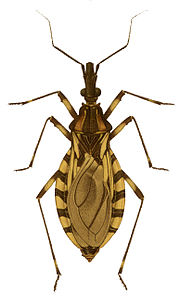The members of the Triatominae /traɪ.əˈtɒmɪniː/, a subfamily of the Reduviidae, are also known as conenose bugs, kissing bugs (so-called from their habit...
20 KB (2,378 words) - 08:00, 10 June 2024
non-predatory Reduviidae are some blood-sucking ectoparasites in the subfamily Triatominae, with a few species from South America noted for their ability to transmit...
16 KB (1,746 words) - 22:21, 10 July 2024
of assassin bug in the subfamily Triatominae (kissing bugs). The members of Triatoma (like all members of Triatominae) are blood-sucking insects that can...
9 KB (755 words) - 13:36, 6 December 2023
a blood-sucking bug (like virtually all the members of its subfamily Triatominae) and the most important vector of Trypanosoma cruzi which can lead to...
12 KB (1,217 words) - 15:16, 11 September 2023
also known as the Eastern Bloodsucking Conenose, is an insect of the Triatominae subfamily, known as kissing bugs. It was first described by John Lawrence...
5 KB (575 words) - 19:41, 4 September 2023
Rhodnius is a genus of assassin bugs in the subfamily Triatominae (the kissing bugs), and is an important vector in the spread of Chagas disease. The...
5 KB (400 words) - 13:36, 6 December 2023
A., et al. (2012). The biology of three Mexican-American species of Triatominae (Hemiptera: Reduviidae): Triatoma recurva, Triatoma protracta and Triatoma...
3 KB (304 words) - 08:04, 26 May 2023
family Pentatomidae. In Chile, it has been confused with kissing bugs (Triatominae), causing unjustified alarm. The average length is 16–20 millimetres...
13 KB (1,438 words) - 18:38, 19 May 2024
metaxytaxa is a species of fossil insect belonging to the subfamily Triatominae (kissing bugs) of the family Reduviidae. Living kissing bugs are blood-sucking...
7 KB (765 words) - 15:22, 6 September 2023
Microtriatoma is a genus of bugs that belongs to the subfamily Triatominae. This genus has two known species: M. borbai (Lent & Wygodzinsky, 1979 (Tc))...
1 KB (103 words) - 20:23, 24 September 2023
subcomplex (Hemiptera: Reduviidae: Triatominae). Acta Tropica. 212: 1-10. Mello, D. A. (1976). Biology of Triatominae (Reduviidae Hemiptera) from North...
11 KB (1,375 words) - 17:22, 9 March 2024
Poinar, G. (2005). "Triatoma dominicana sp. n. (Hemiptera: Reduviidae: Triatominae), and Trypanosoma antiquus sp. n. (Stercoraria: Trypanosomatidae), the...
65 KB (6,522 words) - 19:34, 10 July 2024
Alberproseniini Martínez & Carcavallo, 1977 belongs to the subfamily Triatominae and only has one genus, Alberprosenia Martínez & Carcavallo, 1977, with...
1 KB (94 words) - 19:41, 15 January 2023
Panstrongylus megistus is a blood-drinking insect in the subfamily Triatominae. It is found in the Guianas, Brazil, Bolivia, Paraguay, Uruguay and Argentina...
5 KB (464 words) - 17:06, 6 January 2024
allows a triatominae, a vector of the flagellate, to take a blood meal from the patient. The doctor later inspects the gut of the triatominae for growth...
2 KB (220 words) - 22:25, 28 April 2023
Mepraia is a genus in the subfamily Triatominae, endemic in Chile, and vectors of Chagas disease. Mepraia eratyrusiformis (Del Ponte, 1929) Mepraia gajardoi...
1 KB (105 words) - 13:00, 27 February 2021
Dipetalogaster, a genus of Triatominae, the kissing bugs, has only a single species, Dipetalogaster maxima (often misspelled as "maximus", e.g.), which...
5 KB (497 words) - 01:46, 11 September 2023
Cervantesperedo, Fredy S. Mendoza-Palmero, and Sergio Ibáñez-Bernal. "The Triatominae (Hemiptera: Heteroptera: Reduviidae) of Veracruz, Mexico: Geographic...
9 KB (1,150 words) - 07:01, 4 February 2023
Triatoma dominicana is an extinct species of assassin bug in the subfamily Triatominae, the kissing bugs known from early Miocene Burdigalian stage Dominican...
4 KB (379 words) - 15:50, 24 October 2023
Eratyrus is a genus of insects belonging to the assassin bug subfamily Triatominae. This genus has a wide distribution throughout central and northern South...
1 KB (113 words) - 21:58, 20 January 2024
by Trypanosoma cruzi. It is spread mostly by insects in the subfamily Triatominae, known as "kissing bugs". The symptoms change over the course of the...
67 KB (7,185 words) - 23:31, 8 July 2024
scratches from infected cats Chagas disease Trypanosoma cruzi armadillos, Triatominae (kissing bug) Contact of mucosae or wounds with feces of kissing bugs...
78 KB (6,750 words) - 10:54, 16 June 2024
The Genus Panstrongylus Berg, 1879 belongs to the subfamily Triatominae. It is found in South America. Panstrongylus chinai (Del Ponte, 1929) (Tc) Panstrongylus...
3 KB (272 words) - 13:25, 6 December 2023
Head louse Siphonaptera (fleas) Tabanidae (horse flies) Tantulocarida Triatominae Pea crab Sacculina Hirudinea (some leeches) Monogeneans are flatworms...
4 KB (299 words) - 19:13, 15 May 2024
Retrieved 2019-09-23. Lent, H.; Wygodzinsky, P. (1979). "Revision of the Triatominae (Hemiptera, Reduviidae), and their significance as vectors of Chagas'...
2 KB (118 words) - 20:47, 12 March 2024
(Hemiptera, Triatominae) en el estado brasileño de "Rio Grande do Sul"" [Finding of Triatoma platensis Neiva, 1913 (Hemiptera, Triatominae) in the Brazilian...
2 KB (181 words) - 05:40, 22 January 2024
(2002). "Triatoma rubrovaria (Blanchard, 1843) (Hemiptera, Reduviidae, Triatominae) II: Trophic resources and ecological observations of five populations...
13 KB (1,294 words) - 01:37, 16 May 2024
trypanosomes passed to the recipient in the feces of insects from the subfamily Triatominae (most importantly Triatoma infestans). This group includes Trypanosoma...
19 KB (2,089 words) - 12:26, 16 May 2024
Chagas' disease vector in northeastern Brazil (hemiptera, reduviidae, triatominae)". Am J Trop Med Hyg. 67 (5): 516–20. doi:10.4269/ajtmh.2002.67.516....
6 KB (640 words) - 17:13, 5 January 2024
Abad-Franch, Fernando (2018). "Evolution, Systematics, and Biogeography of the Triatominae, Vectors of Chagas Disease". Advances in Parasitology. Vol. 99. pp. 265–344...
27 KB (3,075 words) - 18:01, 12 April 2024






















